Equine Massage: A Practical Guide (27 page)
Read Equine Massage: A Practical Guide Online
Authors: Jean-Pierre Hourdebaigt

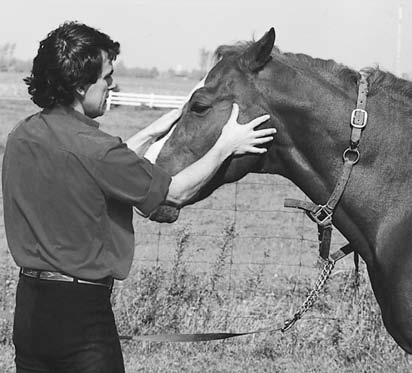
Massage Routines
135
6.19 Working the Forehead:
Second pass, head
massage routine.
6.20 Drainage to the Sides:
Second pass, head
massage routine.
outward (laterally).You might consider using light vibrations from the fingertips while applying this pressure point if the horse does not mind. Repeat below and above the eyes.
Massage the bony depressions above the eye sockets (point 13; figure 6.16) with small, circular fingertip kneadings. Then, using the same move, finish by going from the far corner and under the eyes down to the nostrils (point 14; figure 6.16), repeating 3 times on each side.This will help drain the sinuses further.
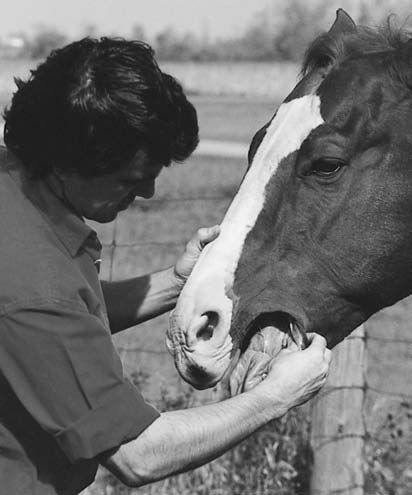
136
Equine Massage
Use light thumb kneadings on and in the nostrils. Be gentle because the drainage hole from the eye into the nostrils is a sensitive area. Complete with plenty of effleurage over the entire face of the horse, effleuraging upward toward the poll.
Third Phase
Using your thumbs or fingers as you prefer, gently friction the gums—front, sides, and the bars (point 15; figure 6.16). Then apply effleurages on the nose ridge (point 16; figure 6.16), toward the cheeks. Massage delicately underneath the jaw (point 17; figure 6.16) to assist drainage. Massage the cheeks (point 18; figure 6.16) for a few moments with finger kneadings and effleurages.
Since the cheek muscles work a good deal and are thus very well developed, you might feel some tension spots. Release these with some gentle friction and drainage.
Use a lot of effleurages to drain the cheeks toward the ears and neck.Then place one hand on each ear and lightly pull it outward.
Repeat 2 or 3 times.Then thoroughly massage the bases of the ears (point 19; figure 6.16) with thumb kneadings and light picking ups. Adjust your pressure to the sensitivity of the animal. Massage the inside of the ears as well; this is a good opportunity to clean out dead skin and inspect the ears for small cuts or insect bites.
6.21 Working the Mouth:
Gums and bars, third
pass, head massage routine.
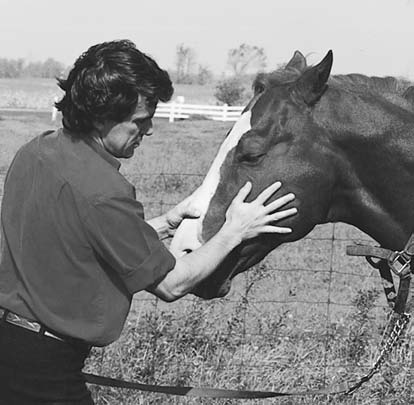
Massage Routines
137
6.22 Finishing the Facial Work with Lots
of Drainage:
Third pass, head massage
routine.
When a horse swallows, his ears move sideways.This movement tells us that the structures of this area—the ears, poll, lower jaw, throatlatch, and upper neck—are all connected. Due to the connection of the deep muscle groups of the spine, tension in these areas might reflect a hindquarter or a back problem. So take the ear at the base (point 20; figure 6.16), pull it gently forward toward yourself and with the other hand open the mouth exactly as you would to make the horse accept the bit.This action will relax tension in the swallowing mechanism; it will also work well in relaxing the upper neck.
Now put your left hand over the ridge of the nose, with the thumb and the index finger placed at the corner of each eye (point 21; figure 6.16), and put your other hand underneath the jaw as though taking the pulse. Stay in this position for a few minutes, breathing in rhythm with your horse. These are very soothing movements with which to complete the facial routine.
You can complement the relaxation process now by applying the relaxation routine.You might also consider the reverse, applying the head massage routine after the relaxation routine.
The head massage routine is very specific work; not every horse will let you work so intimately right away. So do not try this routine on a first massage attempt. In fact, it might take some time before you can do this work on your animal, but when you do manage it, you will find you have created a stronger bond between the two of you.
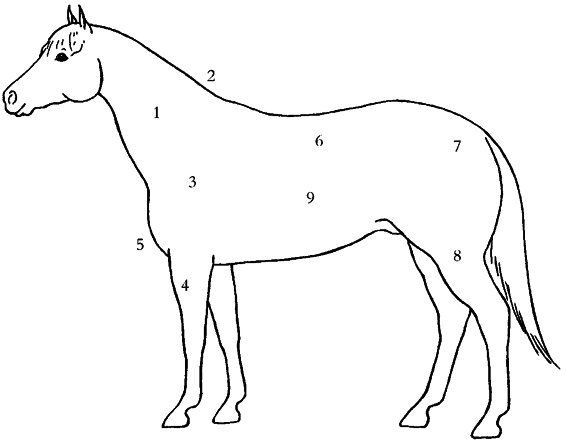
138
Equine Massage
The Maintenance Massage
Routine
In addition to keeping the musculoskeletal structure fit, the maintenance massage routine also gives you a chance to assess and treat all muscle illnesses—tension, knots, stress points, and trigger points—and to detect any other abnormal symptoms.At any time in the maintenance routine, you can add the use of appropriate techniques (see chapter 5) to deal with a particular situation (swellings, stress points, trigger points, etc.). If any abnormal problems arise, check with your veterinarian before proceeding with your massage.
Connect with the animal for a few seconds by talking quietly and gently massaging the poll and the upper neck with light muscle squeezings (point 1; figure 6.23).Then start at the side of the neck with the SEW approach (see chapter 5): apply gentle strokings, from the poll to the withers. Progress into light effleurages covering the entire neck. Use wringings to stir up circulation. Intersperse with effleurages. Use muscle squeezings along the crest of the spine from the ears all the way to the withers. Then with thumb or finger kneadings, thoroughly work the various neck muscles. Intersperse with effleurages every 30 seconds.Your pressure should be light at the beginning, 2 or 3 pounds, progressing to a firmer touch (10 to 15 pounds of pressure).Your overall rhythm should be smooth, 1 to 2 movements per second. Adjust appropriately.
6.23 Maintenance Massage Routine
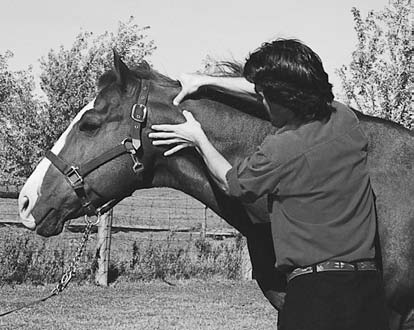
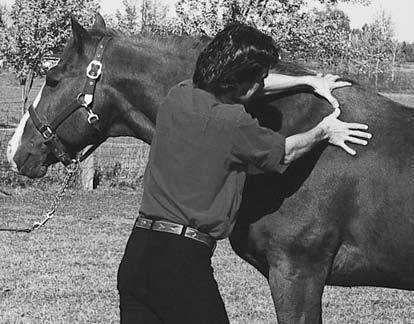
Massage Routines
139
6.24 Neck Work:
With deep double-thumb kneading, maintenance routine.
Moving to the withers area (point 2; figure 6.23), use muscle squeezings, gentle frictions, and thumb kneadings to work all the muscle attachments thoroughly, interspersing every 30 seconds with effleurages (5 to 8 pounds of pressure). When dealing with very developed withers, use muscle compressions with the palms of your hands (12 to 15 pounds) to increase circulation and to loosen the fibers through these tight muscles. Follow with effleurages. When done, use the WES approach to thoroughly drain the side of the neck and withers (see chapter 5). Use one pass of wringing followed by plenty of effleurage. Finish with some gentle stroking over the neck.
6.25 Withers Work:
With deep double-thumb
kneading, interspersed with effleurage, maintenance routine.
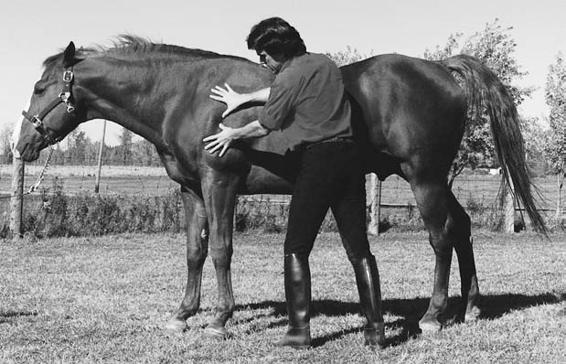
140
Equine Massage
6.26 Shoulder Work:
With deep double-thumb kneading, interspersed with
effleurage, maintenance routine.
Without stopping, proceed to apply the SEW approach over the shoulder area (point 3; figure 6.23). Start with stroking, followed with some effleurages and wringings to warm up the area.
Then use light kneadings (thumbs, fingers, or palms) interspersed with large effleurages along the muscle of the scapula. The serratus thoracis muscle often shows tension; use compression moves to loosen the fibers of this muscle, followed with gentle finger frictions. Drain that area thoroughly with the WES approach.
Apply the SEW approach over the leg (point 4; figure 6.23).
Begin by gently stroking down the foreleg for a grounding effect.
Then, starting at the point of shoulder, use muscle squeezings, picking ups, kneadings, and gentle frictions interspersed with effleurages over the triceps muscle as well as the fleshy part of the flexor and extensor muscle groups, above the knee. Below the knee are only tendons, ligaments, joints, and bones. Gentle muscle squeezings, gentle frictions, and thumb kneadings will loosen the tendons and stimulate circulation all the way down to the hoof; intersperse with effleurages going up the entire leg.
